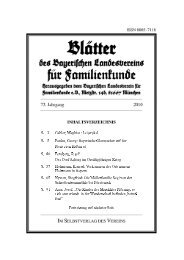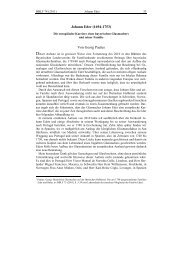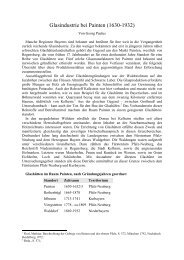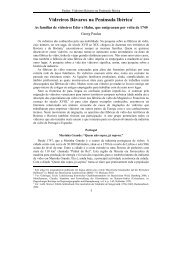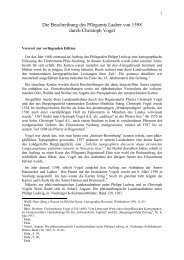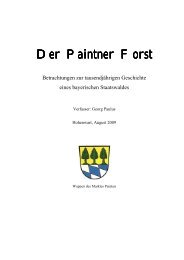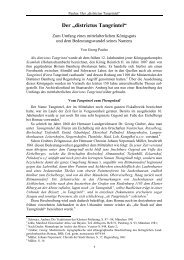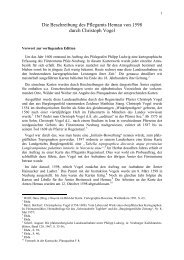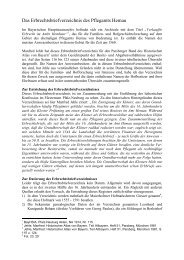Johann Eder - Georg Paulus
Johann Eder - Georg Paulus
Johann Eder - Georg Paulus
You also want an ePaper? Increase the reach of your titles
YUMPU automatically turns print PDFs into web optimized ePapers that Google loves.
<strong>Johann</strong> <strong>Eder</strong> (1694-1753)<br />
The European Career of a Bavarian Glassmaker and his Family 1<br />
by <strong>Georg</strong> <strong>Paulus</strong><br />
In a way, this text is a sequel to an article of 2010 on Bavarian glassmakers, who migrated to<br />
Portugal in 1739/40 and took part in the development of the national glass industry. 2 That<br />
publication has found the attention of both genealogists and glass researchers in several<br />
European countries, who obviously have been dealing with the same glassmakers family <strong>Eder</strong><br />
appearing in my article. However, that family had usually been looked at with regard to their<br />
local relevance only, without the awareness of their importance to other European regions.<br />
About their background it was only known that they had originally come from Germany.<br />
The exchange with those researchers brought forward that, after their emigration, <strong>Johann</strong><br />
<strong>Eder</strong> and his family had not only been active on the Iberian Peninsula but also in Scandinavia.<br />
The insights obtained from the research in Sweden, Norway, Spain and Portugal, as well as<br />
newly revealed sources could now be deepened and brought into a context. This has led to the<br />
awareness that the glassmaker <strong>Johann</strong> <strong>Eder</strong> had lived a remarkable career of European<br />
dimension. The description of that career is the intention of this paper.<br />
In my above mentioned publication of 2010 I have reported in detail on the origin of<br />
<strong>Johann</strong> <strong>Eder</strong> and some stages of his career until his emigration to Portugal, where he appeared<br />
in 1740. Ten years later he was found in Spain, where he played a significant role in the<br />
extension and upgrading of the royal glassworks at San Ildefonso, north of Madrid. At that<br />
time, nothing was known about his path of life between his departure from Portugal and his<br />
arrival in Spain, i.e. the period from 1740 to 1750. That gap can now be filled and thus a<br />
further chapter of the vita of a talented glassmaker can be written, and <strong>Eder</strong>’s role in the<br />
development of glass industries in European foreign countries is gaining new importance.<br />
My special thanks are owed to the genealogists and glass researchers, without whose<br />
personal support and valuable hints this paper could not have been accomplished. Those are in<br />
Portugal: Mr. Victor Manuel de Noronha Gallo, Lisbon, and Mr. Herlander Miguel Francisco,<br />
Maceira, in Sweden: Mr. Kent Williamsson, Stockholm, in Norway: Mrs. Anne Minken,<br />
Oslo, and Mr. Karl-Heinz Cegla, Levanger, in Spain: Dr. Paloma Pastor Rey de Viñas, as well<br />
as the German researchers: Mrs. Doris Sattler, Undorf, and Mr. Andreas Kozlik, Backnang.<br />
<strong>Eder</strong> in Portugal<br />
<strong>Johann</strong> <strong>Eder</strong> had grown up in the glassworks village of Rothenbügl near Painten, west of<br />
Ratisbon (Regensburg), where his father – of the same name – worked as a glassmaker. He<br />
had been baptised on 24th May 1694 at Lam in the Bavarian Forest. 3 At that time his father<br />
was tenant of a glassworks near Eisenstein, before he returned to Rothenbügl, with his family.<br />
When <strong>Johann</strong> <strong>Eder</strong> (son) went to Portugal, in 1739/40, together with his wife, children and<br />
nephews, to work there on the only glass producing site, the royal glass factory of Coina, he<br />
was 45 years of age and already worked at several glassworks in various territories of the<br />
1 Translation of an article published in: Blätter des Bayerischen Landesvereins für Familienkunde, BBLF 74,<br />
Munich 2011, p. 33-50; Original German title: „<strong>Johann</strong> <strong>Eder</strong> (1694-1753). Die europäische Karriere eines<br />
bayerischen Glasmachers und seiner Familie“. Translation by <strong>Georg</strong> <strong>Paulus</strong>, revised by Dr. Miriam J. Baldwin.<br />
2 <strong>Paulus</strong>, <strong>Georg</strong>: Bayerische Glasmacher auf der Iberischen Halbinsel. Die um 1740 ausgewanderten Familien<br />
<strong>Eder</strong> und Hahn, in: Blätter des Bayerischen Landesvereins für Familienkunde, BBLF 73, Munich 2010, p. 5-39<br />
(With details on the individual members of the <strong>Eder</strong> family).<br />
3 Bischöfliches Zentralarchiv, Regensburg , Pfarrmatrikeln Lam, Vol. 1, p. 391.<br />
1
Holy Roman Empire of the German Nation, such as the Palatinate-Neuburg, the Prince-<br />
Bishopric of Würzburg, the Duchy of Saxony-Hildburghausen and Bohemia (here as tenant). 4<br />
<strong>Johann</strong> <strong>Eder</strong>’s activity as mestre do vidro (glass master) in Portugal was only of short<br />
duration. We do not know the date of his arrival nor of his departure. According to his own<br />
statement, he spent altogether seven months in Portugal. We also learn that he had come there<br />
together with 32 Germans to work in the royal glass factory. 5 The exact reasons for him to<br />
leave the country already in 1740 are unknown. The circumstances found there must not have<br />
fulfilled his expectations. Many of the glassmakers who had come with him stayed in the<br />
country. Their descendants worked in the manufacture of glass for a long time. With the Hahn<br />
family, nowadays bearing the lusitanised name Gallo, this is the case even until our days. 6<br />
<strong>Eder</strong>, however, left Portugal to go – as recent findings have revealed – to the other end of<br />
Europe, namely to Sweden. In Coina he left behind his nephews Adam and Balthasar <strong>Eder</strong>,<br />
who became progenitors of the Portuguese glassmakers families Hedre/Hedra, whose descendants<br />
are still to be found in the region of the glass industry site of Marinha Grande. The one<br />
of <strong>Johann</strong> <strong>Eder</strong>’s nephews, Balthasar, was already married, when he arrived in Portugal. His<br />
wife Margarethe, née Horn, gave birth to a daughter in Coina, on 31st March 1740, baptised<br />
Margarida. In her baptism record, Balthasar <strong>Eder</strong> (transcribed as „Hedra“) is identified as son<br />
of Benedikt <strong>Eder</strong>. The parents and grandparents of the child are described as of German<br />
nationality and subjects of the Prince-Bishopric of Würzburg („naturais Wercebult nação<br />
Alemanha“), 7 due to their provenance from the glassworks of Schleichach in the Steigerwald<br />
area, where <strong>Johann</strong> <strong>Eder</strong>’s brother Benedikt had worked until his death in March 1739.<br />
Further archival evidence of the origin of the <strong>Eder</strong>s is to be found in a wedding record of<br />
26th November 1750. It concerns the marriage of Adam <strong>Eder</strong>, the other nephew, with the<br />
Portuguese bride Maria da Silva. The groom is described as follows: „Adam Hedre filho<br />
legitimo de Benedicto Hedre e de sua mulher Maria Hedre jà defuntos da Villa de Pointon<br />
Reyno de Alemanha e Baptizado na frequezia de S. <strong>Georg</strong>e de mesma Villa...” 8 („Adam<br />
Hedre, legitimate son of Benedicto Hedre and his wife Maria, both already deceased, from the<br />
Wedding record of Adam <strong>Eder</strong> („Hedre“) and Maria da Silva, Pataias, Portugal, 26 th November 1750 9<br />
4 Cf. <strong>Paulus</strong>, <strong>Georg</strong>: Bayerische Glasmacher, 2010.<br />
5 Archivo General de Palacio, Madrid (Henceforth: A.G.P.), San Ildefonso, caja 13.584.<br />
6 Cf. <strong>Paulus</strong>, <strong>Georg</strong>: Bayerische Glasmacher, 2010.<br />
7 Arquivo Distrital de Setubal, Portugal, Baptism Records Coina.<br />
8 Arquivo Distrital de Leiria, Portugal, Livro de baptismos da freguesia de Pataias (1746-1811), 2 separate<br />
sheets; (Friendly advice by Mr. Herlander Miguel Francisco, Maceira, Portugal).<br />
9 Ibid.<br />
2
town of Pointon in the Kingdom of Germany, baptised at St. <strong>Georg</strong>e’s parish in the same<br />
town...“). Painten with its glassworks of Rothenbügl, established in 1665, where the <strong>Eder</strong>s had<br />
worked, was often spelt „Pointen“ in Bavarian documents, until the 19 th century.<br />
Many of the glassmakers who had come from Bavaria to Portugal together with <strong>Johann</strong><br />
<strong>Eder</strong> stayed, such as Jakob Fuchs and the brothers Ulrich and <strong>Johann</strong> <strong>Georg</strong> Hahn, the latter<br />
becoming the forefather of the present glass industrialist family Gallo. 10<br />
Sweden<br />
We do not know why <strong>Johann</strong> <strong>Eder</strong> left Portugal after such a short time, nor what made him go<br />
to Sweden. Anyhow, in 1741, we find him and his sons Joseph, <strong>Johann</strong>es and Lorenz at<br />
Kosta, in southern Sweden, where a crystal glass factory was being established and became<br />
operational in 1742. 11<br />
Glass had been manufactured in Sweden since the 16th century. However, glass production<br />
had broken down during the Great Northern War (1700-1721). It took until 1735 before a new<br />
glassworks was again privileged in Sweden. From that year on until 1796, 16 glassworks were<br />
established in Sweden itself – not counting Finnland. Only two had survived from former<br />
times. 12 Also in Finnland, which was part of the Swedish kingdom, the first new glassworks<br />
was founded in 1748, after a preceding one having been closed down in 1685. 13 The<br />
development of the glass industry, forced by the state, brought mainly German glassmakers<br />
into the country. Already the oldest Swedish glassworks had depended predominantly on<br />
German specialists. 14<br />
The efforts of the Swedish government to intensify the national glass production may soon<br />
have got around among the trade. <strong>Eder</strong> may have learned that professionals were sought for<br />
Sweden through his contacts with his former places of employment Schleichach and<br />
Rothenbügl. In this context the brothers <strong>Johann</strong> und Christian Filion who had come to<br />
Sweden from Schleichach in 1737 may have played a role. They travelled to Frankfurt, from<br />
where they returned to Sweden in the spring of 1739. 15 Most probably, the purpose of their<br />
trip had been the recruitment of German glassmakers.<br />
A further possible connection of <strong>Eder</strong> to Sweden could have consisted in Wilhelm Greiner.<br />
The latter had been working as a smelter on the Swedish glassworks of Björknäs, prior to<br />
1739, and later on at Perstorp, from 1742 to 1748. 16 This Wilhelm Greiner is possibly identical<br />
to the smelter of the same name found at the glassworks of Irlbrunn until 1734. He might<br />
have been one of five glassmakers who had come to Björknäs in Sweden from Ratisbon in<br />
December 1736. 17 The glassworks of Irlbrunn was only half an hour’s walk from Rothenbügl,<br />
home of the <strong>Eder</strong>s, and Wilhelm Greiner had been a predecessor of <strong>Johann</strong> <strong>Georg</strong> Hahn (see<br />
above) as a smelter. 18 Those are only examples demonstrating which connections may have<br />
persuaded <strong>Johann</strong> <strong>Eder</strong> to go to Sweden.<br />
10<br />
Cf. <strong>Paulus</strong>, <strong>Georg</strong>: Bayerische Glasmacher, 2010.<br />
11<br />
Fogelberg, Torbjörn; Holl, Friedrich: Wanderungen deutscher Glashüttenleute und Schwedens Glasindustrie in<br />
den letzten fünf Jahrhunderten, Växjö 1988, p. 71, as well as: Anderbjörk, Jan Erik: Kosta Glasbruk 1742-1942,<br />
p. 18, 143 and 222, Stockholm 1942.<br />
12<br />
Fogelberg, Torbjörn; Holl, Friedrich: Wanderungen deutscher Glasmacher und Schwedens Glasindustrie.<br />
Växjö 1988, p. 10.<br />
13<br />
Löfberg, Aimo: Suomen lasinpuhaltajat 1748-1860; Riihimäki 1981, p. 85.<br />
14<br />
Fogelberg, Torbjörn; Holl, Friedrich: Wanderungen deutscher Glasmacher und Schwedens Glasindustrie.<br />
Växjö 1988, p. 9.<br />
15<br />
Ibid., p. 17.<br />
16<br />
Ibid., p. 77.<br />
17<br />
Ibid., p. 15.<br />
18<br />
Cf. <strong>Paulus</strong>, <strong>Georg</strong>: Die Geschichte der Glashütte Irlbrunn, Abensberg 2011 (In print).<br />
3
The fact that he and his sons were present at Kosta as early as in 1741, the year before the<br />
startup of the crystal glass production, makes us assume that they were already involved in its<br />
implementation. The Swedish glass researcher Torbjörn Fogelberg writes about the early<br />
times of Kosta: „The factory at Kosta, the oldest crystal glassworks of Sweden, started in<br />
summer 1742 with skilled German glassworkers. Already at the end of the year 1741, the<br />
masters Johan <strong>Eder</strong>, Johan From, Christopher Schytz and Anewald Waltzer, as well as the<br />
potash maker Johan Banholtz were present on the site. In the following years, 20 more<br />
German glassmakers and engravers are to be found at Kosta. Unfortunately, there is no<br />
information on their origins contained in the account books, which, by the way, are the only<br />
ones preserved from the 18 th century. Only a brief note is found that for the recruitment of the<br />
two Germans named Berger and Hince 274 Daler were spent.“ 19<br />
The glassmaker Berger mentioned by Fogelberg is probably Andres Berger, documented at<br />
Kosta from 1748 to 1750. 20 He could be identical to Andreas Berger, born at Schleichach in<br />
1709. 21 This would correspond to the described relations to that glassworks in the Prince-<br />
Bishopric of Würzburg.<br />
<strong>Johann</strong> <strong>Eder</strong> and his sons are documented at Kosta from 1741 until1744. 22 The eldest of<br />
them, Joseph, worked there as a glass artisan. The two younger brothers, <strong>Johann</strong> and Lorenz,<br />
were still recorded as assistant boys („avdragsgosse“). 23 For 1742, it is reported that <strong>Johann</strong><br />
<strong>Eder</strong> (father) was offered an ox, worth 18 thalers, as a reward for his particular merits in the<br />
establishment of the glassworks. 24<br />
In April, the <strong>Eder</strong> family left Kosta for an unknown destination. 25 Possibly, they moved to<br />
Limmared (approx. 170 km northwest of Kosta), where, in 1740, a glass factory had been<br />
established which was in competition against Kosta. 26 From a correspondence of 1748<br />
between the tenants of the glassworks of Kosta and Limmared we learn that a glassmaker<br />
named <strong>Eder</strong>, who had worked at Kosta before, had been hired out at Limmared. The tenant<br />
Stael von Holstein writes about his former glassmaker <strong>Eder</strong> that that „rogue“ pretended to be<br />
going blind, but that he had come to know that <strong>Eder</strong> was, later on, employed at Limmared. 27<br />
Unfortunately the correspondence does not tell when that happened.<br />
Via Limmared, or a further interstation, <strong>Johann</strong> <strong>Eder</strong>, his wife and the two sons Joseph and<br />
Lorenz ended up in Norway. The third son, <strong>Johann</strong>, obviously stayed in Sweden. This<br />
reminds us of <strong>Eder</strong>’s period in Portugal, where he left his nephews who continued to work in<br />
the manufacture of glass, there. The son <strong>Johann</strong> can be found as a (Catholic) smelter, in 1755,<br />
at the glassworks of Sandö, existing since 1750. 28 There, he married the Swede Karin<br />
Eriksdotter in 1757, and had two children, Margaretha and <strong>Johann</strong> Lorenz. At the baptism of<br />
the latter, the German glass master Heinrich Balthasar Greiner and his wife Susanna<br />
Catharina, née <strong>Eder</strong>, were godparents. 29 Unfortunately, nothing is known about their kinship<br />
with the father of the child. The godfather could be identical to Heinrich Balthasar Greiner,<br />
19 Fogelberg, Torbjörn; Holl, Friedrich: Wanderungen deutscher Glashüttenleute und Schwedens Glasindustrie in<br />
den letzten fünf Jahrhunderten, Växjö 1988, p. 15.<br />
20 Ibid., p. 67.<br />
21 Loibl, Werner: (Fabrik-)Schleichach. Die Geschichte der Glashütte im Steigerwald (1706-1869),<br />
Rauhenebrach 2006, p. 511.<br />
22 Fogelberg, Torbjörn; Holl, Friedrich: Wanderungen deutscher Glashüttenleute und Schwedens Glasindustrie in<br />
den letzten fünf Jahrhunderten, Växjö 1988, p. 71, as well as: Anderbjörk, Jan Erik: Kosta Glasbruk 1742-1942,<br />
Stockholm 1942, p. 18, 143 and 222.<br />
23 Friendly advice by Mr. Kent Williamsson, Stockholm, Sweden;<br />
24 Ibid.<br />
25 Ibid.<br />
26 Cf. Östlund, Karin: Limmared 1740-1940, Ulricehamn 1940.<br />
27 http://www.limmaredsglasmuseum.se/historia/rivalitet-mellan-bruken.html (download: 7th Nov. 2010).<br />
28 Cf. Fogelberg, Torbjörn: Sandö Glasbruk 1750-1928. Ett bidrag till Ådalens industriella historia, Malmö 1968.<br />
29 Friendly advice by Mr. Kent Williamsson, Stockholm, Sweden.<br />
4
who worked as a glass artisan in the Swabian-Franconian Forest in 1734. 30 There, too, an<br />
<strong>Eder</strong> daughter had married a <strong>Johann</strong> Peter Greiner, in 1754. 31 <strong>Johann</strong> <strong>Eder</strong> (son) died at Sandö<br />
on 19 th October 1761. 32<br />
Norway<br />
There is only very little information on <strong>Johann</strong> <strong>Eder</strong>’s stay in Norway. Thus, we do not know,<br />
when he and his family arrived there. Anyhow, this must have been somewhen between 1744<br />
and 1749.<br />
King Christian VI. of Denmark and Norway had built a first crystal glassworks with the<br />
help of glass specialists from England, Bohemia and Germany. That factory was located at<br />
Nøstetangen, in the Norwegian Hokksund, about 60 km west of Oslo (At that time called<br />
Christiania).<br />
The <strong>Eder</strong>s worked there under the bailiff Peter Holm. 33 One of the few and at the same<br />
time the oldest proof of their presence in the Hokksund is a baptism record of the parish of<br />
Eiker, in charge of Nøstetangen: On 10 th August 1749 a Lorenz <strong>Eder</strong>, most probably <strong>Johann</strong>’s<br />
son, appears as a godfather, together with other glassworks people. 34<br />
Here, I would like to point out the particular situation in which the <strong>Eder</strong> family lived, as<br />
Catholics in a strictly Lutheran environment, as it had already been the case in Sweden, and<br />
now again in Norway. To describe those circumstances we can draw upon the research of the<br />
Norwegian historian Anna Minken who has investigated the living conditions of the<br />
immigrants at Norwegian and Swedish glassworks. 35<br />
In the 18 th century, the Norwegian society was strictly conditioned Lutheran. A decree of<br />
1613 even prohibited the presence of Catholics in the country. 36 Only in 1748, that regulation<br />
was eased by an order allowing Catholics to stay in Norway. However, they were still<br />
forbidden to practise their religion. 37 The impression cannot be dismissed that that concession<br />
was granted in the face of the necessity to recruit foreign Catholic glassmakers for the<br />
establishment of a national crystal glass production. For glassblowers, to be German or of<br />
German descent was considered as a kind of guarantee of quality in Norway. 38 This looks like<br />
an example for one of those cases, where a legal custom which has crept in, is sanctioned after<br />
the fact, as Anna Minken has found examples of marriages between Catholics and Lutherans<br />
in the church books of Eiker, prior to 1748: In 1742, the Catholic daughter of a German<br />
glassmaker married a Protestant. In 1746, the Catholic glassmaker Bahnholz married a<br />
Swedish woman of Lutheran confession. 39 The above mentioned godparenthood of the<br />
Catholic Lorenz <strong>Eder</strong> at a Lutheran baptism is a further indication of that oecumenical<br />
practise at Nøstetangen.<br />
The members of the <strong>Eder</strong> family – and probably other glassmakers as well – were<br />
devotional Catholics and very keen to worship and to fulfil their religious duties. That is<br />
30<br />
Ibid.<br />
31<br />
Friendly advice by Mr. Andreas Kozlik, Backnang.<br />
32<br />
Fogelberg, Torbjörn; Holl, Friedrich: Wanderungen deutscher Glashüttenleute und Schwedens Glasindustrie in<br />
den letzten fünf Jahrhunderten, Växjö 1988, p. 71, as well as Fogelberg, Torbjörn: Sandö Glasbruk 1750-1928.<br />
Ett bidrag till Ådalens industriella historia, Malmö 1968, p. 56, 68, 69.<br />
33<br />
Christiansen, Gunnar E.: De gamle privilegerte Norske glassverker og Christiania glasmagasin, Oslo 1939, p.<br />
456.<br />
34<br />
Pfarrbuch Eiker (1724-1753), fol. 149v, Nr. 101 (available on-line).<br />
35<br />
Minken, Anne: Innvandrere ved norske glassverk og etterkommerne deres (1741-1865). En undersøkelse av<br />
etnisk identitet. Bergen, 2002.<br />
36 Ibid., p. 123.<br />
37 Ibid., p. 127.<br />
38 Ibid., p. 159.<br />
39 Friendly advice by Mrs. Anne Minken.<br />
5
witnessed finally by their religious activities shown later on in Spain, where they surpassed by<br />
far their acquittal. 40 Like their fellow believers, they must have felt discriminated and<br />
constricted in the stringent Protestant environment surrounding them in Sweden and Norway.<br />
The other employees from Bavaria, Bohemia and France at the early Norwegian glassworks<br />
must have fared in a similar way. 41 According to Anne Minken the Catholic glassmakers in<br />
Sweden and Norway attached great importance to fulfilling a minimum of their religious<br />
duties, in spite of the prohibition of Catholic worship. They insisted in the privilege to be<br />
allowed to go to Stockholm or Copenhagen, respectively, at least once a year, to go to<br />
confession and to worship. 42 In the said capitals, Catholic envoys of foreign states had been<br />
allowed churches and priests permitting them to practise their religion. Minken reports that<br />
the situation was a little bit easier for Catholic glassmakers in Sweden than in Norway. Some<br />
Swedish employment contracts contain stipulations ensuring them the privilege to travel to<br />
Stockholm to worship, at full reimbursement of costs. In Norwegian contracts no such<br />
concessions were to be found. 43<br />
It was only in 1761, when Catholic priests were permitted to stay in Norway, at all. 44 And<br />
even this was due to the pressure of Catholic glassmakers who had threatened to travel to<br />
Copenhagen, if they were not allowed to receive a Catholic clergyman. The journey from the<br />
Norwegian factories to Copenhagen was long, and the bailiffs at the glassworks did not want<br />
to accept such a long absence of their workers. So, they filed a corresponding petition in 1761,<br />
which was immediately accepted by King Frederick V., one of the major shareholders in the<br />
glassworks. Thereupon, a Catholic priest visited Christiania in September 1761 45 , where at<br />
least ten glassmakers gathered for Communion. Also at later visits of Catholic priests, they<br />
only went as far as Christiania. The glassmakers had to pay for their own travelling costs as<br />
well as for those of the priests. 46<br />
For weddings and baptisms, the Catholics could make use of the services of the Lutheran<br />
church. At weddings between Catholics and Lutherans, the couple had to vow to bring up<br />
their offspring in the Lutheran belief. In cases of death, Minken found examples where<br />
Catholics were buried without ceremony and spiritual succour. Some deaths of Catholics were<br />
recorded in the Lutheran church book without any comment. 47<br />
While several conversions were found in Sweden, the Catholic glassmakers who had come<br />
to Norway seem to have stayed with their belief, despite the implicated constraints. Following<br />
generations, however, were registered as Lutherans. 48 Religious liberty for Catholics was<br />
granted in Norway in 1843, only. 49<br />
Besides the particular religious circumstances, Minken has investigated many other aspects<br />
of the living conditions of the immigrant glassmakers, such as the linguistic environment and<br />
its interactions. For example, she reports that the contracts with glassmakers were generally<br />
drafted in their native language – German or English, respectively – if they did not speak the<br />
Danish official language. 50 Correspondingly, the factory rules of Nøstetangen were bilingual –<br />
40<br />
Cf. <strong>Paulus</strong>, <strong>Georg</strong>: Bayerische Glasmacher, 2010.<br />
41<br />
Minken, Anne: Innvandrere ved norske glassverk og etterkommerne deres (1741-1865). En undersøkelse av<br />
etnisk identitet. Bergen, 2002, p. 124;<br />
42<br />
Ibid., p. 167.<br />
43<br />
Friendly advice by Mrs. Anne Minken .<br />
44<br />
Minken, Anne: Innvandrere ved norske glassverk og etterkommerne deres (1741-1865). En undersøkelse av<br />
etnisk identitet. Bergen, 2002, p. 126.<br />
45 Nowadays: Oslo.<br />
46 Friendly advice by Mrs. Anne Minken .<br />
47 Ibid.<br />
48 Ibid.<br />
49 Minken, Anne: Innvandrere ved norske glassverk og etterkommerne deres (1741-1865). En undersøkelse av<br />
etnisk identitet. Bergen, 2002, p. 124;<br />
50 Ibid., p. 174.<br />
6
Danish and German. 51 Minken also explains that numerous German technical terms of the<br />
glass trade have found their way into the Norwegian language. 52<br />
The Recruitment for Spain<br />
According to the available facts, <strong>Johann</strong> <strong>Eder</strong> must have left Norway after August 1749, or in<br />
early summer of 1750, at the latest. From there, the family went – possibly via Germany – to<br />
Spain. 53 Certainly, the religious restraints, described above, were one of the reasons for the<br />
devout Catholic <strong>Johann</strong> <strong>Eder</strong> and his family not wanting to stay in Norway forever and to<br />
look for new challenges in a Catholic environment.<br />
Unexpectedly, after the publishing of my article „Bayerische Glasmacher auf der<br />
Iberischen Halbinsel“ („Bavarian Glassmakers on the Iberin Peninsula“) a source has been<br />
discovered giving information where and how <strong>Johann</strong> <strong>Eder</strong> was recruited for Spain. Until<br />
then, Spanish glass researchers had assumed that he had been recruited in Paris, together with<br />
French glassmakers arriving at the same time. That assumption has now turned out to be<br />
wrong. The Spanish painter Antonio Ponz (1725-1792) had travelled Spain in 1771. In 1781<br />
he published a book on this journey, entitled „Viage de España“. 54 Therein, he also describes<br />
the glass factory of La Granja de San Ildefonso which he had visited, and he reports on the<br />
recruitment of the glass master <strong>Johann</strong> <strong>Eder</strong>. We may assume that this report is based on an<br />
interview with the head of the factory, <strong>Johann</strong> <strong>Eder</strong>’s eldest son Joseph. The latter was 27<br />
years old, when his family came to Spain, and he had accompanied his father on his journeys<br />
as an adolescent and later on as an adult.<br />
According to Ponz, <strong>Johann</strong> <strong>Eder</strong> was recruited in Copenhagen by the envoy of the Spanish<br />
King. 55 Most probably, this took place at the occasion of one of those journeys which had led<br />
the family to Copenhagen to attend church. Here is the translation of Ponz’s report:<br />
“The fame of that establishment [San Ildefonso] had spread beyond Spain, and a Master<br />
named <strong>Eder</strong>, who held a factory of his own in Norway, 56 came to Copenhagen to meet the<br />
Spanish envoy, and proposed that he would like to come to San Ildefonso to establish a new<br />
factory, if the King agreed with the conditions he would propose. He offered to blow large<br />
glass that would serve for doors, windows, cabinets, canvas, etc. without the necessity of<br />
operations like grinding and polishing. The King accepted him to come with those persons<br />
whom he would consider helpful; after having proceeded so, <strong>Eder</strong> established the factory<br />
named today “Primera de entrefinas”, because the glass made there is of such quality that<br />
also an assortment of crystal vases, flasks and bottles and many other things are being made,<br />
there. The King assigned a salary to Master <strong>Eder</strong> and to his two sons Joseph and Lorenzo, the<br />
former of them being, nowadays, the Master of this operation and, as well as of that of<br />
“Planos finos” [= fine plate glass].“ 57<br />
This important contemporary source confirms <strong>Eder</strong>’s previous stay in Norway. Other later<br />
records also mention <strong>Eder</strong>’s Norwegian provenance. In Francisco Reuleaux’s encyclopedic<br />
work “Los grandes inventos. Fabricación y elaboración del vidrio” of 1889, the glass master<br />
of San Ildefonso, <strong>Johann</strong> <strong>Eder</strong>, is referred to as „El maestro <strong>Eder</strong> de Noruega“ („Master <strong>Eder</strong><br />
51<br />
Ibid., p. 175.<br />
52<br />
Ibid., p. 189-191.<br />
53<br />
Cf. <strong>Paulus</strong>, <strong>Georg</strong>: Bayerische Glasmacher, 2010.<br />
54<br />
Ponz, Antonio: Viage de España: en que se da noticia de las cosas mas apreciables, y dignas de saberse, que<br />
hay en ella; Madrid 1781.<br />
55<br />
Ibid., p. 128-129.<br />
56<br />
The statement that <strong>Eder</strong> owned a glass factory in Norway is not correct. The glassworks of Nøstetangen was a<br />
royal enterprise. At the utmost, <strong>Eder</strong> was a forman, there.<br />
57<br />
Ponz, Antonio: Viage de España: en que se da noticia de las cosas mas apreciables, y dignas de saberse, que<br />
hay en ella; Madrid 1781, p.128-129.<br />
7
from Norway“). 58 Other Spanish sources call <strong>Eder</strong> a Swede. 59 It is doubtful whether we may<br />
conclude from this, that <strong>Johann</strong> <strong>Eder</strong> had become a Swedish subject during his years at Kosta<br />
and Limmared. Anyhow, it is obvious that <strong>Eder</strong>’s original provenance from Germany, or even<br />
Bavaria, had widely fallen into oblivion.<br />
Besides the prospect of a life in a Catholic country, the concessions offered and the<br />
commitments of the Spanish court to the conditions tabled by the obviously self-confident<br />
glassmaker may have been decisive for <strong>Eder</strong>’s departure for Spain.<br />
Compared to the living conditions in the forbidding woodlands of Sweden and Norway,<br />
where the family had spent almost a complete decade, the prospect of living in the Spanish<br />
San Ildefonso with all its comfort of an urban environment, unreserved possibility to worship,<br />
at sighting distance from the summer residence of the Spanish King, must have appeared to<br />
them like paradise.<br />
The Arrival in Spain<br />
As we have seen in Ponz’s report on <strong>Eder</strong>’s recruitment in Copenhagen, he was asked to come<br />
to Spain ” with those persons whom he would consider helpful”. This did not only enable him<br />
to bring along his wife Ursula, his grown-up sons Joseph and Lorenz, with whom he had<br />
already worked in Sweden and Norway (His third son, <strong>Johann</strong>, had stayed in Sweden.). It also<br />
allowed him, at his discretion, to recruit other glassmakers, whom he found qualified and with<br />
whom he got along well with. Thus, the German glass engravers family Gubbe 60 came with<br />
him from Norway to Spain. 61 <strong>Johann</strong> Wentzel Gubbe had initially worked in Sweden, from<br />
1735, onwards, at Kungsholm 62 and finally, 1744, at the glassworks of Limmared. 63 After<br />
that, he had gone to Norway like <strong>Eder</strong>, before accompanying him to Spain. The brothers<br />
Heinrich, Daniel, <strong>Johann</strong> and Siegismund Brun 64 followed and arrived at San Ildefonso a few<br />
months later, in January 1751. 65 <strong>Eder</strong> had also worked with these Germans, already in<br />
Norway. 66 Moreover, there are indications suggesting a kinship between the <strong>Eder</strong> and the<br />
Brun families. The Brun brothers had brought along their mother, while their father continued<br />
to work in Norway. 67 The four brothers were immediately assigned to <strong>Johann</strong> <strong>Eder</strong>’s factory.<br />
The Brun family also settled down in Spain, and their descendants continued to work at San<br />
Ildefonso. Siegismund, who later on called himself Simon Brun, in 1770 became director of<br />
the newly established forth section at San Ildefonso, the „Fábrica Segunda de Entrefinos“. 68<br />
Another document brought forward, recently, gives insight into <strong>Eder</strong>’s first days at San<br />
Ildefonso: The Royal Archives of the Palace in Madrid keep a revealing report, written down<br />
on 5 th October 1750, a fortnight after <strong>Eder</strong>’s arrival. 69 Its author is Marqués de Galiano<br />
58 Reuleaux, Francisco: Los grandes inventos. Fabricación y elaboración del vidrio, Madrid 1889, p. 608.<br />
59 Cf. Riaño, Juan F.: The Industrial Arts in Spain, London 1879, p. 244.<br />
60 Other spellings: Guba, Goba.<br />
61 Pastor Rey de Viñas, Paloma: Historia de la Real Fábrica de Crystales de San Ildefonso durante la Epoca de la<br />
Ilustración (1727-1810), San Ildefonso 1994, p. 149, as well as De Pablos y Viejo, Eliseo, in: Iglesias Gil: La<br />
Real Fábrica de Crystales de la Granja: Su significación histórica y la fabricación de vidrios planos de grandes<br />
dimensiones, p. 87-97 (p. 89), in: José Manuel (Ed.): Cursos Sobre el Patrimonio Histórico 3. Actas de los IX<br />
Cursos Monográficos sobre el Patrimonio Histórico, Reinosa 1998.<br />
62 Seitz, Heribert: Äldre svenska glas med graverad dekor, Stockholm 1936, p. 203.<br />
63 Östlund, Karin: Limmared 1740-1940, Ulricehamn 1940, p. 27.<br />
64 Other spellings: Brum, Braun.<br />
65 Pastor Rey de Viñas, Paloma: Historia de la Real Fábrica de Crystales de San Ildefonso durante la Epoca de la<br />
Ilustración (1727-1810), San Ildefonso 1994, p. 150.<br />
66 Friendly advice by Mrs. Anne Minken.<br />
67 Friendly advices by Mrs. Anne Minken, as well as by Dr. Pastor Paloma Rey de Viñas.<br />
68 Pastor Rey de Viñas, Paloma: Historia de la Real Fábrica de Crystales de San Ildefonso durante la Epoca de la<br />
Ilustración (1727-1810), San Ildefonso 1994, p. 154-155.<br />
69 A.G.P., San Ildefonso. Caja, 13.584; My special thanks to Mr. Herlander Miguel Francisco, Maceira, Portugal,<br />
for the copy of that document..<br />
8
intendant of the Royal Site of San Ildefonso. Its addressee was José de Carvajal y Láncaster<br />
(1698-1754), royal counsellor and president of the Council of Commerce and Mint („Junta de<br />
Comercio y Moneda“). Therein, de Galiano refers to a meeting with <strong>Johann</strong> <strong>Eder</strong>. Besides<br />
details on <strong>Eder</strong>’s glass recipes he describes the German glassmaker as a man of few words but<br />
good character („hombre de pocas palabras, y bueno!“), whose determined approach<br />
obviously impressed him. That document, based on a conversation with <strong>Johann</strong> <strong>Eder</strong>, shall be<br />
given as a translation:<br />
„Yesterday evening, I called for Juan <strong>Eder</strong>, the German master, and his companions to<br />
come to my house. He had already been to Portugal to establish the production of crystal,<br />
together with 32 Germans. After seven months, he returned to his country, as things did not<br />
go well in Portugal.<br />
I asked him various questions to learn something about his way of operation and his<br />
recipes, assisted by a poor and worthless interpreter, found on the spot. My questions were<br />
answered adequately and I became assured that you will be satisfied with his work. He<br />
appeared to me as a man of few words but good! Traits which can be seen from his face.<br />
He asked me for four hundred bushels of ashes of oak-wood, sufficient for six months. I<br />
have given order to Sr. Domingo Sani(?), that all ashes from the hearths, as they burn day<br />
and night, particularly in winter, shall be collected and delivered to the servants, to be stored.<br />
And, though he reassured me that ashes of any kind of wood would be good, he explained that<br />
yonder was the best. Of the stone [limestone?] suitable for his composition, he would store<br />
sufficient quantity, as he made me understand. The deeper the stone was found, the whiter it<br />
is, and consequently the whiter becomes the crystal. Thus, his composition would consist of<br />
ashes, stone, arsenic and salpetre.<br />
He told me that he did not want Frenchmen to work with him but only Spaniards, whom he<br />
would teach in everything that he knew. He suggested choosing willing and striving men, so<br />
that they took advantage of their time to the profit of the King.<br />
They gave me a wooden model after which their iron blowpipes should be made.<br />
Today, they have begun to trace the furnace and to level the spot where it shall be built,<br />
and the Germans are already preparing the pité.<br />
You can be assured that it will not take long until everything is prepared and that they will<br />
not fall short of anything.<br />
You are requested to arrange that they will not lack salpetre nor other materials which<br />
they may ask M. Berger for.”<br />
De Galiano’s impression proved to be correct: The expectations of the Spanish Court on<br />
<strong>Johann</strong> <strong>Eder</strong> and his collaborators were more than fulfilled. The „Fábrica de Entrefinos“ at<br />
San Ildefonso, established and managed by him, became an enterprise which was both technologically<br />
and economically successful. After <strong>Johann</strong> <strong>Eder</strong>’s death in 1753 it was carried on by<br />
his son Joseph. It flourished and gained international recognition 70<br />
<strong>Johann</strong> <strong>Eder</strong>’s Brothers at Glassworks in the Duchy of Württemberg<br />
As we have seen above, there were relationships between the Swedish glassworks of Sandö<br />
and glassworks in the Duchy of Württemberg through the <strong>Eder</strong> and Greiner families who<br />
were manifold related by marriage. The glassmaker Heinrich Balthasar Greiner, working at<br />
Sandö and supposed to have worked at Neulautern glassworks, before, was married to a<br />
Susanna Catharina <strong>Eder</strong> (see above).<br />
At the glassworks in the Swabian-Franconian Forest in Württemberg two elder brothers of<br />
<strong>Johann</strong> <strong>Eder</strong> are to be found. The biographies of the <strong>Eder</strong> brothers are examples of the wellknown<br />
fact that sons of glassmakers usually took up the profession of their fathers. The<br />
70 Cf. <strong>Paulus</strong>, <strong>Georg</strong>: Bayerische Glasmacher, 2010.<br />
9
others <strong>Johann</strong> (G1673) und Lorenz <strong>Eder</strong> (G1686) 71 , both born at Rothenbügl worked at the<br />
glassworks of Jux, Spiegelberg and Joachimstal in the Swabian-Franconian Forest. In 1701,<br />
the eldest brother is already documented at Jux as „Hannß <strong>Eder</strong>, gebürtig von Bainten bey<br />
Kehlheimb, 26 Jahr alt, hat Weib ohne Kind, Cathol. Religion, will sich hier bürgerlich<br />
einlaßen und bawen.“ 72 The other brother, Lorenz <strong>Eder</strong>, is found at the neighbouring<br />
Joachimstal, in 1721, where he is mentioned as „Glaser von Baindten, kurpfälzische Glashütte“.<br />
73 A further source of from 1746 from Joachimstal mentions his widow and his three<br />
daughters: „Lorenz <strong>Eder</strong>s Wittib, 3 Kinder, die Mutter und 2 Töchter katholisch, die 3. evangelisch.<br />
Bewerb: Betteln. Ort vorigen Aufenthalts: aus dem Jux“; 74 This Lorenz is almost<br />
certainly <strong>Johann</strong> <strong>Eder</strong>’s brother, born at Rothenbügl in 1686, who worked at Jux prior to<br />
1721. In 1754, his daughter Katharina Margaretha married the glassmaker <strong>Johann</strong> Peter<br />
Greiner, probably a relative of Heinrich Balthasar Greiner, found in Sweden (see above). 75<br />
Thus, the families <strong>Eder</strong> and Greiner were the tie between glassworks sites in the Duchy of<br />
Württemberg, in Sweden and in the forests north of the Bavarian town of Kelheim (Rothenbügl<br />
and Irlbrunn).<br />
Economic and Cultural-Historical Background<br />
The career of the Bavarian glassmaker <strong>Johann</strong> <strong>Eder</strong>, which took him to Portugal, Sweden,<br />
Norway and finally to Spain, in the period between 1739 and 1750, inevitably raises the<br />
question why, particularly in that period, production of glass was promoted apparently in the<br />
most different regions of Europe. If we take a closer look into the historical circumstances,<br />
several factors can be detected, the interaction of which resulted in an intensification of glass<br />
production. The causes are mainly of economic-political and cultural-historical nature.<br />
Cultural Changes<br />
One of the reasons is to be found in cultural changes taking place, at that time, in Europe. One<br />
of them is an increasing demand for consumer goods. Glass was no longer considered a<br />
luxury good, only available to a small upper class. Since the late 17 th century, even in modest<br />
households cutlery, glasses, bowls and cups were to be found. The economic historian Paolo<br />
Malanima writes: „The growing use of those things is a slow process, varying from region to<br />
region, related to new habits and table manners. Cutlery, bowls and glasses increased in<br />
numbers, because they were used personally and no longer collectively, as before.“ 76 Also,<br />
window glass became more and more common. This improvement of living conditions<br />
accelerated during the 18th century in the course of a “consumer revolution” as it is called by<br />
some historians. 77<br />
71 In Bavaria, it was not unusual that children of the same parents were given the same first names, even if the<br />
elder child of the same name was still alive (Cf: <strong>Paulus</strong>, <strong>Georg</strong>: “3 Söhnlein namens <strong>Johann</strong>es”. Zum Phänomen<br />
der Namensgleichheit von Geschwistern, in: Blätter des Bayerischen Landesvereins f. Familienkunde, BBLF 68,<br />
p. 1-10, Munich 2005.<br />
72 “Hans (= <strong>Johann</strong>) <strong>Eder</strong>, born at Painten near Kelheim, 26 years old, has wife and child, Cathol. religion...”;<br />
„Specification deren beraits bey der Glaß-Hütten im Jux befindlichen Laboranten und Holtzhewer. Actum auf<br />
der Glaßhütten im Jux d. 16. Juny 1701“ (Friendly advice by Mr. Andreas Kozlik, Backnang).<br />
73 „Glassmaker from Painten, glassworks of the Electoral Palatinate“; Hasenmayer, Marianne: Eine Glashütte<br />
im Klosterwald, in Marski, Ulrike: Das Forsthaus Joachimstal. Ordnung und Freiheit, Natur und Ökonomie.<br />
Schwäbisch Hall 2006, p. 22; (Friendly advice by Mr. Andreas Kozlik, Backnang).<br />
74 „Lorenz <strong>Eder</strong>’s widow, 3 children, the mother and 2 daughters Catholic, the 3rd Protestant...“; Ibid., p. 34.<br />
75 Friendly advice by Mr. Andreas Kozlik, Backnang.<br />
76 Malanima, Paolo: Europäische Wirtschaftsgeschichte. 10.-19. Jahrhundert, Vienna 2010, p. 364-365.<br />
77 Ibid., p. 366.<br />
10
Economic-Political Causes<br />
The intensification of glass production in many parts of Europe and the foundation of royal or<br />
royally privileged glassworks in the first half of the 18 th century happen against the background<br />
of an economic policy dominated by mercantilism. One of its goals was to encourage<br />
industrial development by direct governmental intervention. In the 18 th century, most European<br />
states went forward with a long mercantilist tradition of governmental support and promotion<br />
of certain manufacturing sectors. Their example was France, where, since the late 17 th<br />
century, manufactures royales and manufactures privilégiées of the metallurgical industry and<br />
industries producing arms or luxury goods were privileged with monopolies, tax advantages,<br />
subventions and similar benefits. 78 One of those establishments was la manufacture royale<br />
des glaces, founded by Louis XIV., where the mirrors for the castle of Versailles had been<br />
produced.<br />
The predominant economic goal of that policy was to become independent of imports – in<br />
our case of glass products – and to improve the financial situation of the respective ruler, by<br />
the revenues from the royal manufactories.<br />
In Spain and Portugal, moreover, the supply of the overseas colonies, particularly in<br />
Southern and Central America, played a role. By intensifying glass production in the respective<br />
mother country, the provision of the colonial territories could be improved. Import bans<br />
or customs duties on glass goods, as they are documented for Portugal, 79 protected the local<br />
production from competition – particularly from Southern Germany and Bohemia. 80 This<br />
supported their own factories and improved the trade balance.<br />
Also in Sweden, the achievement of a positive trade balance had been a declared goal of<br />
the economic policy, since the reign of Queen Christina (1632-1654). 81 Also Norway was<br />
determined to better use „the riches of mountains, woodlands and the sea“, since the 18 th<br />
century. For that purpose, in 1739, the royally privileged “Black Company” was established<br />
under the direction of the German J. F. von Beust. It comprised the implementation of a<br />
national glass industry. Thus, the glass factories of Nøstetangen, Sandsvær, Hurdal and<br />
Hadeland were established between 1742 and 1756. They were supported by orders for the<br />
Court and high import duties on foreign glass goods. 82 Under King Frederick V. (1746-1766)<br />
mercantilism reached its height in the Danish-Norwegian federation. 83 In 1760, imports of<br />
glass were banned totally. Hence, the Norwegian glassworks disposed of the monopoly in the<br />
two Kingdoms 84<br />
The described economic activities which had brought about the establishment of numerous<br />
glass factories on the Iberian Peninsula and in Scandinavia, in the 18 th century, corresponded<br />
to the absolutist regime. However, the proclaimed intention of autocratic royalty and its<br />
central bureaucracy to promote the economic potential of the country was only superficial.<br />
The main purpose was to strengthen the influence and power of the state. 85 Another aspect not<br />
to be neglected is the increase of the prestige for the respective Court, which went along with<br />
the establishment of its own crystal factories and the luxury goods produced there.<br />
78<br />
Cf. Supple, Barry: Der Staat und die industrielle Revolution 1700-1914, in: Cipolla, Carlo Maria; Borchardt,<br />
Kurt (Ed.): Europäische Wirtschaftsgeschichte, Vol. 3, Stuttgart 1985, p. 201-202.<br />
79<br />
Murphy, James Cavanah: Travels in Portugal, S. 83, London 1795; Quoted after Wilson Frothingham, Alice:<br />
Hispanic Glass with Examples in the Collection of The Hispanic Society of America, New York 1941, Extract<br />
in: Geiselberger, Sigmar: Pressglas-Korrespondenz 2008-2.<br />
80<br />
Wilson Frothingham, Alice: Hispanic Glass with Examples in the Collection of The Hispanic Society of<br />
America, New York 1941, Extract in: Geiselberger, Sigmar: Pressglas-Korrespondenz 2008-2.<br />
81<br />
Blaich, Fritz: Die Epoche des Merkantilismus, Wiesbaden 1973, p. 184-185.<br />
82<br />
Johnsen, Oscar Albert: Norwegische Wirtschaftsgeschichte, Jena 1939, p. 366.<br />
83<br />
Ibid., p. 373.<br />
84<br />
Ibid., p. 366.<br />
85<br />
Cf. Supple, Barry: Der Staat und die industrielle Revolution 1700-1914, in: Cipolla, Carlo Maria; Borchardt,<br />
Kurt (Ed.): Europäische Wirtschaftsgeschichte, Vol. 3, Stuttgart 1985, p. 201-202.<br />
11
Transfer of Technology<br />
In the early 18th century, the production of baroque style glass with engraved motifs spread in<br />
Bohemia and Germany. Its technical base was the so called crystal or chalk glass<br />
(“Kristallglas” or “Kreideglas”), which had been developed in Bohemia, towards the end of<br />
the 17 th century. 86 This was the decisive technological step forward, which finally made the<br />
glass from Venice, until then considered as unequalled, lose its importance, and the baroque<br />
style “Kristallglas” from the Bohemian and German glassworks to dominate the market. The<br />
founders and tenants of the crystal glassworks in other European countries, who wanted to<br />
make use of that new technology, relied on the knowledge and skills of Bohemian and<br />
German glassmakers. <strong>Johann</strong> <strong>Eder</strong> and his sons mastered the new technique of making crystal<br />
glass. <strong>Eder</strong>’s career is also an example how individual specialists participated in the transfer<br />
of technology and how it was brought forward by the communication networks of artisans and<br />
by their mobility.<br />
As we have learned from the description of Antonio Ponz 87 and the comprehensive<br />
publication of Paloma Pastor on the history of the glass factory of San Ildefonso 88 , the <strong>Eder</strong>s<br />
were hollow glass makers. Even the flat glass which they made was produced by blowing. For<br />
that purpose they blew hollow cylinders, which were then cut open and processed to glass<br />
plates. The production of flat glass by casting was practised by the <strong>Eder</strong>s, at a later stage, in<br />
Spain, where Joseph <strong>Eder</strong> (1723-1782) ran the factory for flat glass (Fábrica de planos) of San<br />
Ildefonso.<br />
<strong>Johann</strong> <strong>Eder</strong>s other son, Lorenz, who had – like Joseph – accompanied his father on his<br />
journeys through Europe, had specialised in the engraving of glass and reached high skills in<br />
it. Glass objects accredited to him, can still be found in renowned museums, e.g. the National<br />
Archaeological Museum (Museo Arqueologico Nacional) in Madrid, and in Glasgow. 89<br />
Conclusion<br />
Some chapters of the life of <strong>Johann</strong> <strong>Eder</strong> (1694-1753) still remain unknown (see Chronological<br />
Table). For instance, we do not know when and where he got married, nor where he<br />
lived during the period between 1723 until his escape from Bergreichenstein, in 1738, 90 nor<br />
where his sons Lorenz and <strong>Johann</strong> were born. Anyway, the last 16 years of his life, certainly<br />
the most important chapter, could now be described. When <strong>Johann</strong> <strong>Eder</strong> left Germany at the<br />
age of 45 to go to Portugal, he already disposed of a wide experience as a glassmaker and<br />
tenant of a glassworks. After that, he spent ten years in Sweden and Norway, where he took<br />
part in the establishment of the crystal glassworks at Kosta und Nøstetangen, the first ones of<br />
their kind in the said two countries. The height of his career was certainly when he managed<br />
to be employed by the King of Spain and was put in charge of the construction and direction<br />
of the „Fábrica de Entrefinos“ at San Ildefonso, in 1750. This way, he had also provided for<br />
the future of his sons Joseph und Lorenz, who achieved fame and glory within the<br />
glassmakers’ guild of Spain. Before that, he had managed to place his nephews Adam and<br />
Balthasar with the glass factory in the Portuguese Coina. His son <strong>Johann</strong> worked as a smelter<br />
at Sandö in Sweden.<br />
86 Cf. Hirsch, Ernst: Die Erfindung des böhmischen Kristallglases. Ein Beitrag zur Geschichte der Glasindustrie<br />
auf der Buquoy'schen Herrschaft Gratzen in Südböhmen, in: Mitteilungen des Vereins für Geschichte der<br />
Deutschen in Böhmen, 1936.<br />
87 Ponz, Antonio: Viage de España: en que se da noticia de las cosas mas apreciables, y dignas de saberse, que<br />
hay en ella; Madrid 1781, p.128-129.<br />
88 Pastor Rey de Viñas: Historia de la Real Fábrica de Crystales de San Ildefonso durante la Epoca de la<br />
Ilustración, San Ildefonso 1994.<br />
89 Cf. http://collections.glasgowmuseums.com/starobject.html?oid=81993 (download: 23 Jan. 2011).<br />
90 Cf. <strong>Paulus</strong>, <strong>Georg</strong>: Bayerische Glasmacher, 2010.<br />
12
<strong>Johann</strong> <strong>Eder</strong>s skills and those of his sons are witnessed by the reports on the history of the<br />
glass factory of San Ildefonso, as well as by numerous of their works which have been<br />
preserved: for example the mirrors from Joseph <strong>Eder</strong>’s factory, to be seen in the Royal Palace<br />
of Madrid, or the engraved glass objects accredited to Lorenz <strong>Eder</strong> and kept in various<br />
European museums.<br />
By their journeys, leading them across Europe, in the course of some ten years, and their<br />
international activity, <strong>Johann</strong> <strong>Eder</strong>, his sons and nephews, contributed to a transfer of technology<br />
by which the highly developed art of making glass spread from Bavaria and Bohemia<br />
throughout Europe.<br />
Chronological Table<br />
20.11.1672 Marriage of <strong>Johann</strong> <strong>Eder</strong>s the Elder with Barbara Degenmayer, Rothenbügl<br />
25.06.1691 2nd marriage of <strong>Johann</strong> <strong>Eder</strong> the Elder with Margarethe Ittel, Rothenbügl<br />
1694-1697 <strong>Johann</strong> <strong>Eder</strong> the Elder as glassworks tenant at Eisenstein<br />
24.05.1694 Baptism of <strong>Johann</strong> <strong>Eder</strong> at Lam<br />
17.18.1723 <strong>Johann</strong> <strong>Eder</strong> as a glassmaker at Rothenbügl<br />
04.03.1723 Baptism of Joseph <strong>Eder</strong>s at Painten<br />
14.06.1723 Death of <strong>Johann</strong> <strong>Eder</strong>s the Elder at Rothenbügl<br />
1738 <strong>Johann</strong> <strong>Eder</strong> as glassworks tenant at Bergreichenstein, Bohemia<br />
22.10.1738 <strong>Johann</strong> <strong>Eder</strong> at Schleichach<br />
1739 Application of <strong>Johann</strong> <strong>Eder</strong>s at Eisfeld, Saxony-Hildburghausen<br />
30.03.1739 Death of the brother Benedikt <strong>Eder</strong> at Schleichach<br />
1739-1740 <strong>Johann</strong> <strong>Eder</strong> at Coina, Portugal (Documented: March 1740)<br />
1741-1744 <strong>Johann</strong> <strong>Eder</strong> at Kosta, Sweden (Documented from 1741 onwards)<br />
< 1748 <strong>Johann</strong> <strong>Eder</strong> at Limmared, Sweden<br />
10.08.1749 Lorenz <strong>Eder</strong> as godfather at Nøstetangen, Norway<br />
22.09.1750 Arrival of the <strong>Eder</strong>s at La Granja de San Ildefonso, Spain<br />
06.07.1753 Death of <strong>Johann</strong> <strong>Eder</strong> at San Ildefonso<br />
1755 <strong>Johann</strong> <strong>Eder</strong> III., smelter, arrives to Sandö.<br />
1764 Joseph <strong>Eder</strong> gets in charge of the factory for flat glass at San Ildefonso<br />
21.03.1782 Death of Joseph <strong>Eder</strong> at San Ildefonso<br />
Literature (Selection):<br />
— Anderbjörk, Jan Erik: Kosta Glasbruk 1742-1942, Stockholm 1942;<br />
— Christiansen, Gunnar E.: De gamle privilegerte Norske glassverker og Christiania<br />
glasmagasin, Oslo 1939;<br />
— Correia, Joaquim: A Fábrica dos Vidros de João Beare na Marinha Grande, Marinha<br />
Grande 1999;<br />
— Custódio, Jorge: A Real Fábrica de Vidros de Coina (1719-1747) e o vidro em Portugal<br />
nos séculos XVII e XVIII, Lisbon 2002;<br />
— Fogelberg, Torbjörn: Sandö Glasbruk 1750-1928. Ett bidrag till Ådalens industriella<br />
historia, Malmö 1968;<br />
— Fogelberg, Torbjörn; Holl, Friedrich: Wanderungen deutscher Glashüttenleute und<br />
Schwedens Glasindustrie in den letzten fünf Jahrhunderten, Växjö 1988;<br />
— Minken, Anne: Innvandrere ved norske glassverk og etterkommerne deres (1741-1865).<br />
En undersøkelse av etnisk identitet. Bergen, 2002;<br />
— Östlund, Karin: Limmared 1740-1940, Ulricehamn 1940;<br />
13
— Pastor Rey de Viñas, Paloma: Historia de la Real Fábrica de Crystales de San Ildefonso<br />
durante la Epoca de la Ilustración (1727-1810), San Ildefonso 1994;<br />
— <strong>Paulus</strong>, <strong>Georg</strong>: Bayerische Glasmacher auf der Iberischen Halbinsel. Die um 1740<br />
ausgewanderten Familien <strong>Eder</strong> und Hahn, in: BBLF 73, Munich 2010, p. 5-39;<br />
— <strong>Paulus</strong>, <strong>Georg</strong>: Glasindustrie bei Painten (1630-1932), in: Die Oberpfalz, Jg. 98, Heft 4,<br />
Kallmünz 2010, p. 230-239;<br />
________________________________<br />
14



